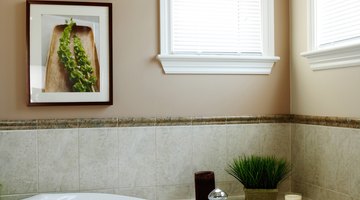How to Build a Tub Box for a Drop-In Tub
Regardless of what type of tub you are installing, there needs to be some kind of base frame in place to support the weight of the tub.

In addition to helping support the tub, the frame acts as a base for any finish material you plan on installing on the face of the tub area and on top of the deck area, such as ceramic tile or natural slate stone tile. The overall principle of building a tub frame is the same as any other type of box frame, requiring only basic carpentry knowledge, skill and tools.
Things You Will Need
- Safety glasses
- Work gloves
- Tape measure
- Carpenter's square
- Circular saw
- 2-by-4 material
- 4-foot level
- Drill
- 3-inch wood screws
- 1 1/2-inch wood screws
- 3/4-inch plywood
- Construction adhesive
-
Measure the height of the tub and add at least 3 inches to this measurement so that you have room to set the tub in mortar after the frame is ready. Also add at least 6 inches on each side of the depth (front to back area) so you have extra space on top of the tub deck for tile or other finish elements. For the length of the tub, either add an extra 6 inches on each side or run the frame wall to wall if you have an already-made enclosure.
-
Cut your two-by-fours down to size with the circular saw. Mark the pieces with a tape measure, pencil and square. You need four two-by-fours along the bottom of the frame, laid down on their sides so that the 4-inch width spans the floor. Prepare another four pieces for the upper part of the frame. You will also need four pieces for the sides and four pieces for the front and back. Screw your floor pieces down into the subfloor.
-
Cut down your vertical support pieces. These need to be placed every 16 inches around the entire tub frame, just like wall studs. Cut an appropriate number based on the size of your tub, at the height determined by the size of your tub. Remember that your top and bottom frame pieces add 4 inches of overall height to your tub deck, so cut your vertical supports accordingly.
-
Screw your vertical support pieces onto the bottom support pieces. Start with the corner pieces and attach them to the wall studs as well as the bottom supports. Orient the screws into the wood at a 45-degree angle. Then set your top support pieces on top of the vertical supports. Use the level to help guide your placement and keep things plumb. Then screw the upper pieces of the frame (which are the same size as the bottom pieces) into the vertical supports and into the wall studs where appropriate with the 3-inch screws.
-
Measure the width, length and depth of your tub deck across the top and transfer those measurements to the piece of plywood. Cut it down to size. Apply wood glue to the tops of the wood deck frame and place the plywood sheet in place. Screw it down onto the frame with the 1 1/2-inch wood screws. Use the circular saw to cut out the plywood according to the dimensions of your tub.
Tip
You can double up the framing if you want to add extra support. The reason you build the tub a few extra inches high is to ensure there is room for the mud mortar to be placed under the tub during its installation to help support the weight of the tub when it is filled with water. The extra facial dimensions provide room for tile or other finish materials. You can adjust these as you see fit if you just want the frame large enough to support the tub without any extra space.
Warning
Wear safety gear when working with power tools.
The Drip Cap
- Regardless of what type of tub you are installing, there needs to be some kind of base frame in place to support the weight of the tub.
- In addition to helping support the tub, the frame acts as a base for any finish material you plan on installing on the face of the tub area and on top of the deck area, such as ceramic tile or natural slate stone tile.
- Measure the height of the tub and add at least 3 inches to this measurement so that you have room to set the tub in mortar after the frame is ready.
- Cut your two-by-fours down to size with the circular saw.
- Screw your vertical support pieces onto the bottom support pieces.
- Start with the corner pieces and attach them to the wall studs as well as the bottom supports.
Resources
Writer Bio
Tim Anderson has been freelance writing since 2007. His has been published online through GTV Magazine, Home Anatomy, TravBuddy, MMO Hub, Killer Guides and the Delegate2 group. He spent more than 15 years as a third-generation tile and stone contractor before transitioning into freelance writing.
Photo Credits
- Jupiterimages/Photos.com/Getty Images
- Jupiterimages/Photos.com/Getty Images
More Articles



